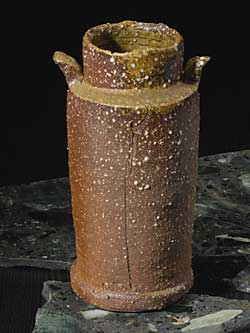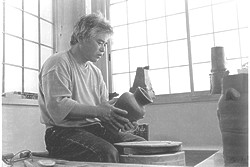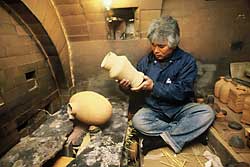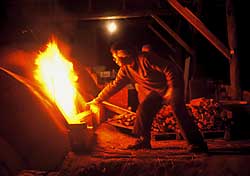 |

|
Japanese Art Shop |
|
Japanese Art Shop >> Honma's ceramics |
|
Written by Kenji Kaneko 
Fujisawa, the city in which Shinichi Honma's workshop is located, lies in the southern part of Iwate Prefecture in northeastern Japan. The largest river of the region, the Kitakami river, flows near the city. It crosses Iwate Prefecture from north to south at a length of 250 kilometers. Over time the river has shaped the rich natural surroundings of the landscape and favoured the cultural development of Iwate. Advanced cultures of all ages formed significant cultural areas along river courses. During the Heian Period (794-1192) a Buddhism-influenced culture flourished in Hanaizumi. On the Kitakami river lived the two national writers and poets, Miyazawa Kenji (1896-1933) in Hanaizumi and Ishikawa Takuboku (1886-1912) in the village of Shibutami. In this sense the Kitakami river bestowed the grace of nature also upon Shinichi Honma. He uses clay from Iwate Prefecture and explains: "Along both sides of the Kitakami many layers of clay with different types of clay can be found. Fujisawa lies to the left of the river on which two types of clay can be found that I both use: one is coarse grained with low iron content; the other is fine grained with a high iron content." In northeastern Japan there are more ruins and sites of the Jomon culture than anywhere else in Japan and, in my opinion, it would be no exaggeration to look at the Jomon-Noyaki Festival in the context of the cultural events of this countryside as the continuity of a culturally contemporary event. Shinichi Honma, one of the most important supporters of cultural events in Fujisawa, discovered relatively late, at the age of 24 years in 1972, the direction of his way, which lead him to ceramics. During the course of his university studies he suffered from inner conflict as to whether he should continue his studies of Japanese history. He decided to leave university. During his search for a new direction he took to the material of clay. After long, critical, self-educating analysis of this material he was definite in his decision for his passion and there were no more doubts about its rightness. The strong charisma of his pottery bears testimony to this will. Honma's pottery forms are structurally simple, geometric and therefore of impressive charisma. The physique of his pottery is created out of his dynamic energy in the use of the material clay. He rarely uses feldspar glazings. He prefers natural ash glazing, which, due to the contact with fly ash during firing, forms vitreous or crusty surfaces with an extremely ascetic and sober atmosphere. Honma's ceramics are created out of his vitality and his knowledge of the special characteristics of the clays, from their selection of the process of giving form to things to their completion in the fire. In this interaction I discover Honma's world and recognize his originality. When I view Honma's ceramics I understand the insight which shapes his work and I am filled with anticipation of what else he will create from it. photo:Vase "yakishime-mimitsuki-hanaike" |
|
|
|
SHINICHI HONMAProfile 1948:Born in Kogotacho, Miyagi Prefecture. 1973:Built semiunderground through-draft kiln(anagama) in Nishifukagaya Fuzizawacho, Iwate Prefecture, and began making pottery. 1983:Built a 20m semiunderground through-draft kiln(anagama) in Higashihukagaya, Fujizawacho. 2004:Solo Exhibition at Musium for Applied Art Gera in Germany 2006:Solo Exhibition at Gallery of Touhoku Institute of Technology in Sendai 2007:Solo Exhibition at sendai mediatheque in Sendai The Other Solo Exhibitions at Shinjuku Keio , Ginza Matsuya,Umeda Hankyu, Daimaru,Sendai Vivre etc. |



|